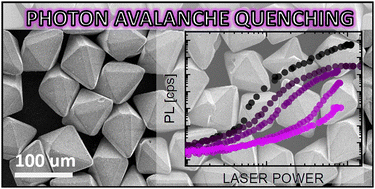The mechanisms behind the extreme susceptibility of photon avalanche emission to quenching
Title: The mechanisms behind the extreme susceptibility of photon avalanche emission to quenching
Authors: Martyna Majak, Małgorzata Misiak, Artur Bednarkiewicz
Journal: Materials Horizons
DOI: 10.1039/D4MH00362D

In their work, the prof.A.Bednarkiewicz group focused on the photon avalanche (PA) emission phenomenon in lanthanide doped materials, and in particular the authors focused on theoretical as well as experimental evaluation of the extraordinary sensitivity of this phenomenon to quenching. The subject of the study were avalanching LiYF4 microcrystals doped with thulium ions and co-doped with neodymium ions. The intentional neodymium dopant was selected to disrupt processes leading to photon avalanche emission by resonant energy transfer from looping or emitting thulium energy levels. The selection of microcrystals was to purposefully eliminate surface unspecific quenching.
To understand the way PA is quenched, the influence of resonant energy transfer from the looping, the emitting or both energy levels was modeled aiming to show how these different quenching paths affect parameters describing photon avalanche emission. The simulation results show that when energy transfer from the looping state (kET2 ) occurs, the photon avalanche threshold shifts to a higher pump power density with increasing acceptor concentration. This transfer affects the PA slope as well as the final emission intensity to a lesser extent. In contrast, energy transfer from the emitting level (kET3) mainly influence the PA slope, leading to a decrease of the slope with increasing acceptor concentration, and influence the PA threshold much less.
Experimental studies on micromaterials in which photon avalanche emission is based on Tm3+ ions, with addition of small and rising amounts of Nd3+ ions as a quencher, show that in this system both energy transfer pathways kET2 and kET3 are present.
The experimental results confirm the simulated significant sensitivity of the photon avalanching material to the presence of an energy acceptor. This indicates that photon avalanche emitting materials have a high application potential in ultrasensitive sensing of physical quantities or specific analytes.
See also
- The Institute
- General information
- Employees
- News
- Scientific News
- Gender equality plan
- Address and contact data
- Research
- Research profile
- List of publications
- List of projects
- International cooperation
- Information in BIP
- Scientific Council
- Organizational structure
- GDPR


